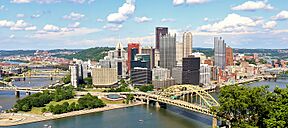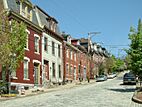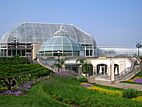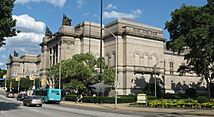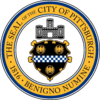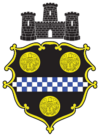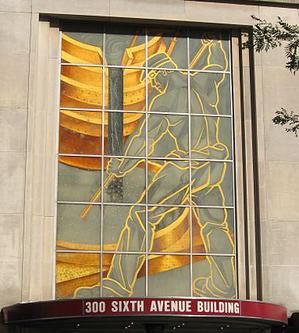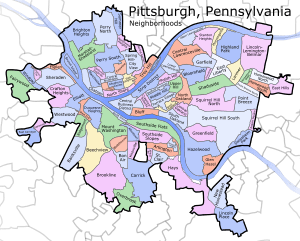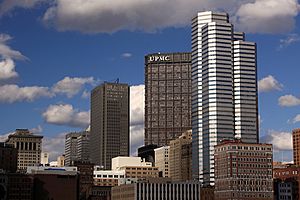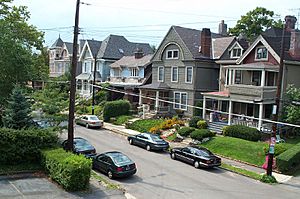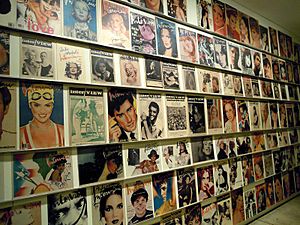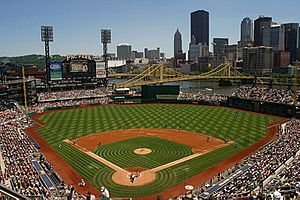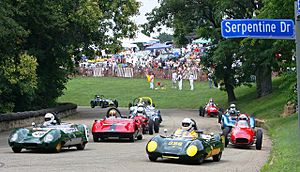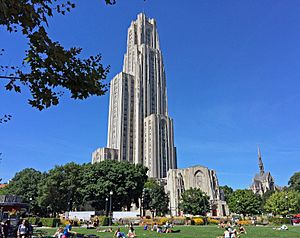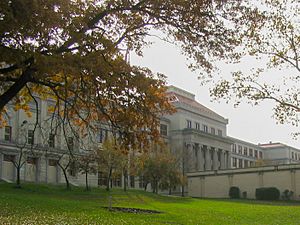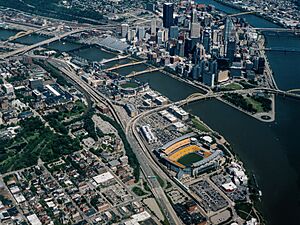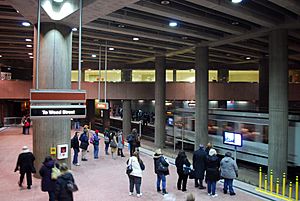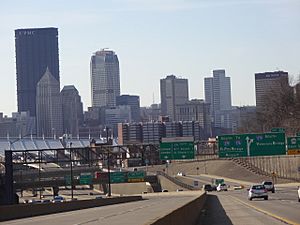Pittsburgh facts for kids
Quick facts for kids
Pittsburgh
|
|||||
|---|---|---|---|---|---|
|
|||||
| Nickname(s):
City of Bridges, Steel City,
City of Champions, The 'Burgh, The Paris of Appalachia |
|||||
| Motto(s):
Benigno Numine ("With the benevolent deity")
|
|||||
| Country | United States | ||||
| State | Pennsylvania | ||||
| County | Allegheny | ||||
| Founded | November 27, 1758 (fort) | ||||
| Municipal incorporation |
|
||||
| Founded by | John Forbes | ||||
| Named for | William Pitt, 1st Earl of Chatham | ||||
| Government | |||||
| • Type | Mayor-council | ||||
| Area | |||||
| • City | 58.35 sq mi (151.12 km2) | ||||
| • Land | 55.38 sq mi (143.42 km2) | ||||
| • Water | 2.97 sq mi (7.70 km2) | ||||
| Highest elevation | 1,370 ft (420 m) | ||||
| Lowest elevation | 710 ft (220 m) | ||||
| Population
(2020)
|
|||||
| • City | 302,971 | ||||
| • Rank | 68th in the United States 2nd in Pennsylvania |
||||
| • Density | 5,471.26/sq mi (2,112.47/km2) | ||||
| • Urban | 1,745,039 (US: 30th) | ||||
| • Urban density | 1,924.7/sq mi (743.1/km2) | ||||
| • Metro | 2,457,000 (US: 26th) | ||||
| Demonym(s) | Pittsburgher, Yinzer | ||||
| GDP | |||||
| • Pittsburgh (MSA) | 3.3 billion (2022) | ||||
| Time zone | UTC−5 (Eastern Standard Time) | ||||
| • Summer (DST) | UTC−4 (Eastern Daylight Time) | ||||
| ZIP Code |
76 total ZIP codes:
15122, 15201-15244, 15250-15255, 15257-15262, 15264-15265, 15267-15268, 15270, 15272, 15274-15279, 15281-15283, 15286, 15289-15290, 15295
|
||||
| Area codes | 412, 724, 878 | ||||
| FIPS code | 42-61000 | ||||
| GNIS feature ID | 1213644 | ||||
|
Pennsylvania Historical Marker
|
|||||
| Designated: | 1946 | ||||
Pittsburgh is a big city in Pennsylvania, USA. It's the second-largest city in the state, right after Philadelphia. About 300,000 people live here. Pittsburgh is special because it sits where two rivers, the Allegheny River and the Monongahela River, meet to form the Ohio River. This area is called Western Pennsylvania.
Pittsburgh is often called "the Steel City" because it was once a huge center for making steel. It was also known as the "City of Bridges" because it has 446 bridges! In the past, many companies had their main offices here. Later, the steel industry changed, and Pittsburgh became a leader in healthcare, education, and technology.
Today, Pittsburgh is home to many hospitals, like the University of Pittsburgh Medical Center, and lots of colleges, including Carnegie Mellon University and the University of Pittsburgh. It's also a hub for things like cyber defense, robotics, and energy research. The city has many cool places to visit, such as the Carnegie Museums of Pittsburgh, the Pittsburgh Zoo & Aquarium, and the Phipps Conservatory and Botanical Gardens. Sports fans love Pittsburgh for its professional teams: the Pittsburgh Steelers (football), Pittsburgh Penguins (hockey), and Pittsburgh Pirates (baseball).
Contents
Discovering Pittsburgh
How Pittsburgh Got Its Name
Pittsburgh got its name in 1758 from General John Forbes. He named it after a British leader, William Pitt, 1st Earl of Chatham. When it was first named, people probably said it like "PITS-buh-ruh," similar to how "Edinburgh" is said.
Pittsburgh officially became a "borough" (a type of town) on April 22, 1794. Later, on March 18, 1816, it became a city. For a while, from 1891 to 1911, the government spelled the city's name "Pittsburg" without the "h." But after people campaigned, the "h" was put back.
A City with a Rich Past
Long ago, the area where Pittsburgh is now was home to Native American tribes like the Shawnee. The first European explorer to visit was René-Robert Cavelier, Sieur de La Salle in 1669. Later, French and British soldiers fought over this important river meeting point. The French built Fort Duquesne, but the British took control in 1758 and built Fort Pitt, named after William Pitt, 1st Earl of Chatham.
After the American Revolution, Pittsburgh grew. It became a place where boats were built for settlers moving west. The first newspaper, the Pittsburgh Post-Gazette, started here in 1786. In 1794, there was a protest called the Whiskey Rebellion, which led to federal troops coming to the area. By 1797, glassmaking began, and the town's population grew.

The War of 1812 helped Pittsburgh's industries grow, especially iron and glass. By 1815, the city was making a lot of these products. In 1845, a huge fire destroyed many buildings, but the city was rebuilt with the help of immigrants. By 1857, Pittsburgh had 1,000 factories!
The American Civil War made the city's economy even stronger because of the high demand for iron and weapons. In 1875, Andrew Carnegie started making steel, and his company, Carnegie Steel Company, became very famous. By 1910, Pittsburgh was the 8th largest city in the U.S., producing a huge amount of the nation's steel. Many immigrants from Europe came to work in the mills.
During World War II, Pittsburgh's mills worked non-stop, producing 95 million tons of steel for the war. This earned the city the nickname "arsenal of democracy." After the war, Pittsburgh started a big project called the "Renaissance" to clean up its air and rivers.
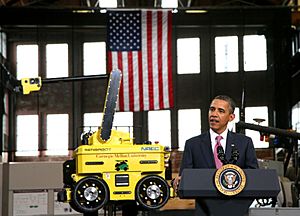
In the late 20th century, the steel industry declined. Pittsburgh then changed its focus to education, tourism, healthcare, and high-tech fields like robotics. Even though the city's population is smaller than it was during the steel boom, Pittsburgh has successfully changed its economy. During the late 2000s, when many cities struggled, Pittsburgh actually added jobs and saw housing prices go up. This success inspired President Barack Obama to host a big international meeting, the 2009 G20 Pittsburgh summit, in the city.
Pittsburgh's Location and Layout
Geography and Rivers
Pittsburgh is located on the Allegheny Plateau. The most famous part of the city, Downtown (also called the Golden Triangle), is where the Allegheny River and Monongahela River meet to form the Ohio River. This meeting point is at Point State Park.
The city has many hills, and you'll find lots of two-lane roads winding through them. Many neighborhoods even have "hills" or "heights" in their names! Pittsburgh is also famous for its outdoor public stairways, with over 700 sets of stairs that offer amazing views.
There are many bike and walking trails along the rivers and in the valleys. You can even bike from Pittsburgh all the way to Washington, D.C., on a continuous trail!
City Areas and Neighborhoods
Pittsburgh has a Downtown area, known as the Golden Triangle, and four main areas around it: the North Side, South Side, East End, and West End. These are divided into 90 unique neighborhoods.
Golden Triangle (Downtown)
Downtown Pittsburgh has many tall buildings, including the U.S. Steel Tower. The Cultural District is a lively area downtown with theaters and art places. It's also becoming a popular place to live. Downtown is easy to get to by subway and many bridges. Point Park University and Duquesne University are also located here.
North Side
The North Side used to be its own city called Allegheny City before it joined Pittsburgh. It has many older homes with interesting architecture. This area is home to popular spots like Heinz Field (where the Steelers play), PNC Park (where the Pirates play), the Carnegie Science Center, National Aviary, and The Andy Warhol Museum.
South Side
The South Side was once a busy area for railroad and mill workers. Now, it's a popular place with unique shops, restaurants, and lively nightlife, especially along East Carson Street. The SouthSide Works is a newer development with stores, restaurants, and offices, built on the site of an old steel mill.
East End

The East End is where you'll find many universities, including the University of Pittsburgh and Carnegie Mellon University. It also has the Carnegie Museums of Pittsburgh, Phipps Conservatory, and the Pittsburgh Zoo & Aquarium. Neighborhoods like Shadyside and Squirrel Hill are known for their shops and homes. Oakland is busy with students, and Bloomfield is Pittsburgh's "Little Italy." Lawrenceville is a growing area popular with artists. The Strip District is a fun outdoor market by day and a place for clubs at night.
West End
The West End includes Mt. Washington, famous for its amazing views of the Downtown skyline. It also has many residential neighborhoods like Sheraden.
Pittsburgh's Weather
Pittsburgh has four distinct seasons. Winters are cold and often snowy. Spring and fall are usually mild and sunny. Summers are warm and humid. The city gets about 38 inches of rain each year and about 41 inches of snow.
People of Pittsburgh
Population and Backgrounds
Pittsburgh's population was about 302,971 people in 2020. Over the years, the city's population has changed, with fewer people living in the city center compared to its peak in the 1950s.
Pittsburgh has a mix of different backgrounds. Many people have European roots, especially German, Irish, and Italian. There's also a large Black and African American community, mainly in the East End. Smaller Asian and Hispanic communities also live here.
Neighborhood Cultures
Many of Pittsburgh's neighborhoods still show their unique cultural roots from when immigrants first arrived. For example:
- German: Troy Hill, Mt. Washington, and East Allegheny (Deutschtown)
- Italian: Brookline, Bloomfield (Pittsburgh's Little Italy), Morningside, Oakland
- Hispanic/Latino: Beechview/Brookline
- Central European: South Side, Lawrenceville, and Polish Hill
- African American: Hill District, Homewood, Larimer, and Hazelwood
- Jewish: Squirrel Hill
Some neighborhoods on the edge of the city feel more like suburbs, with tree-lined streets and yards. Areas like Oakland, the South Side, the North Side, and Downtown have more buildings close together and a busy, urban feel.
Pittsburgh's Economy
Pittsburgh has changed a lot since its steel industry declined. Now, it's a leader in high technology, robotics, healthcare, education, and tourism. In 2007, the technology industries in the region paid out over $10.8 billion in salaries!
The biggest employer in Pittsburgh is the University of Pittsburgh Medical Center (UPMC), which has over 48,000 employees. Healthcare jobs make up about 10% of all jobs in the region. Education is also a major part of the economy, with the University of Pittsburgh being a large employer.
Many big companies have their headquarters in the Pittsburgh area. These include The Kraft Heinz Company, U.S. Steel, PNC Financial Services, and Dick's Sporting Goods. Companies like Google have offices in renovated old factories, showing how Pittsburgh has moved from heavy industry to technology. This change has made Pittsburgh a great example for other cities.
Pittsburgh is also known for its "green buildings" that are designed to be good for the environment. The city's film industry is growing too, with many movies and TV shows being filmed here.
In recent years, Pittsburgh has often been named one of the "most livable cities in the world" by magazines like Metropolis and The Economist.
Arts and Culture in Pittsburgh
Entertainment and Museums

Pittsburgh has a rich history in arts and culture. You can find places like Heinz Hall for the Performing Arts and the Benedum Center, where the Pittsburgh Symphony Orchestra and Pittsburgh Opera perform. There are also many smaller theater groups and dance companies.
Many major films have been shot in Pittsburgh, including The Dark Knight Rises. Pittsburgh is also known as the birthplace of the modern zombie film genre, thanks to director George A. Romero and his 1968 film Night of the Living Dead.
Pittsburgh has great art museums like The Andy Warhol Museum and the Carnegie Museum of Art. The Carnegie Museum of Natural History has amazing collections of dinosaurs and ancient Egyptian artifacts. For science lovers, there's the Kamin Science Center. The Children's Museum of Pittsburgh offers interactive exhibits for kids.
The Pittsburgh Zoo & Aquarium, Phipps Conservatory and Botanical Gardens, and the National Aviary are popular attractions. Pittsburgh is also home to the amusement park Kennywood and the Rivers Casino. The city hosts Anthrocon, the world's largest furry convention, which brings thousands of visitors and boosts the local economy.
Music Scene
Pittsburgh has a long history of jazz, blues, and bluegrass music. Famous musicians like Billy Strayhorn and Mary Lou Williams grew up here. More recently, Pittsburgh artist Wiz Khalifa had a number one hit with "Black and Yellow," a song celebrating Pittsburgh's colors. Other artists like Christina Aguilera and the band Rusted Root also have ties to the area.
Pittsburgh has a strong heavy metal music scene and is known for its punk rock and Hardcore punk bands. The city also has a lively electronic music scene, with popular dance parties and DJs.
Theatre and Literature
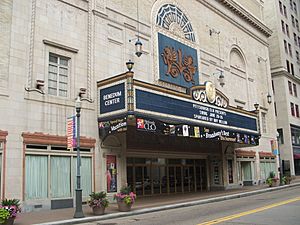
Pittsburgh has a vibrant theater scene. The city's first play was performed in 1803. Universities like the University of Pittsburgh and Carnegie Mellon University have their own theater groups. The Duquesne University Tamburitzans are famous for their folk songs and dance from different cultures.
Pittsburgh is the hometown of the famous playwright August Wilson. His plays often tell stories about the African American experience. The August Wilson House in Pittsburgh celebrates his life and work.
Many famous writers are from Pittsburgh, including Gertrude Stein and Rachel Carson. David McCullough, a two-time Pulitzer Prize winner, was born and raised here. Pittsburgh has also influenced children's television shows like Mister Rogers' Neighborhood.
Local Food and Dialect
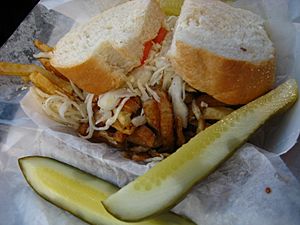
Pittsburgh is known for its unique foods, like pierogies, kielbasa, and chipped chopped ham sandwiches. The city was even named "Food City of the Year" in 2019! Pittsburgh also hosts Picklesburgh, a popular pickle-themed festival.
The local way of speaking English in Pittsburgh is called Pittsburghese. It was influenced by immigrants from different parts of Europe. People who speak it are sometimes called "Yinzers." Some common Pittsburghese words include "slippy" (slippery) and "redd up" (clean up).
Sports in Pittsburgh
Pittsburgh is a big sports city! It hosted the first professional football game and the first World Series. In 2009, it was named the "Best Sports City" in the U.S.
Pittsburgh's major professional sports teams all share the same colors: black and gold. These are the official city colors! This is unique in the U.S. The teams are:
- The Pittsburgh Steelers (football)
- The Pittsburgh Penguins (hockey)
- The Pittsburgh Pirates (baseball)
Professional Sports Teams
| Team | Founded | League | Sport | Venue | Championships |
|---|---|---|---|---|---|
| Pittsburgh Pirates | 1882 | Major League Baseball (MLB) | Baseball | PNC Park | 7 |
| Pittsburgh Steelers | 1933 | National Football League (NFL) | Football | Acrisure Stadium | 6 |
| Pittsburgh Penguins | 1967 | National Hockey League (NHL) | Hockey | PPG Paints Arena | 5 |
Baseball
The Pittsburgh Pirates baseball team is the city's oldest professional sports team, started in 1881. They play at PNC Park. The Pirates have won the World Series five times. Pittsburgh also has a rich history with Negro league baseball teams like the Pittsburgh Crawfords.
Football

The Pittsburgh Steelers football team is very popular. They have been owned by the same family, the Rooney family, since 1933. The Steelers have won six Super Bowls, which is a league record! Their home games at Acrisure Stadium have been sold out since 1972.
The University of Pittsburgh's football team, the Panthers, also plays at Acrisure Stadium. They have won nine national championships.
Hockey
The Pittsburgh Penguins hockey team started in 1967. They have won five Stanley Cup championships. Their home arena is the PPG Paints Arena. Before that, they played in the Civic Arena, also known as "The Igloo."
College Sports
Pittsburgh has strong college sports teams. The University of Pittsburgh's Panthers and Duquesne University's Dukes are well-known for basketball. Robert Morris University also has competitive teams.
Other Sports
The Riverhounds are Pittsburgh's professional soccer team. They also wear black and gold and play at Highmark Stadium.
Golf is very popular in the area. The oldest U.S. golf course still in use, Foxburg Country Club, is nearby. Many famous golfers, like Arnold Palmer, started their careers on Pittsburgh courses.
Pittsburgh is also known for professional wrestling, with many famous wrestlers and promoters coming from the city.
Annual Sporting Events
Pittsburgh hosts several big annual sporting events:
- The Three Rivers Regatta (boat races)
- The Pittsburgh Vintage Grand Prix (car races)
- The Dirty Dozen Cycle Race (a tough bike race up steep hills)
- The Pittsburgh Marathon
- The Great Race 10K (a running race)
Education in Pittsburgh
Colleges and Universities

Pittsburgh is home to many colleges and universities. The most famous are Carnegie Mellon University (CMU), the University of Pittsburgh (Pitt), and Duquesne University.
- Carnegie Mellon University was founded by Andrew Carnegie and Andrew Mellon. It's known for its computer science, engineering, and fine arts programs.
- The University of Pittsburgh, or "Pitt," was started in 1787. It has a large research program and is known for its medical and health sciences schools.
- Duquesne University is a private Catholic university known for its law, business, and pharmacy programs. It also has a famous song and dance group called the Duquesne University Tamburitzans.
Other colleges in the city include Carlow University, Chatham University, and Point Park University.
Schools for Younger Students
The Pittsburgh Public Schools system includes many special schools called charter and magnet schools. These schools focus on different areas, like technology, arts, or gifted programs. Some examples are City Charter High School (for computers and technology) and Pittsburgh Creative and Performing Arts School (for arts).
There are also many private schools in Pittsburgh, such as Central Catholic High School and Oakland Catholic High School.
Pittsburgh has a great library system. The Carnegie Library of Pittsburgh is one of the largest public libraries in the country.
Media in Pittsburgh
Newspapers and TV
Pittsburgh has two main newspapers: the Pittsburgh Post-Gazette and the Pittsburgh Tribune-Review (which is now online only). There are also weekly papers that cover business, local news, and specific communities.
The city has several local TV stations. WQED 13 is the local PBS station. It was the first community-sponsored TV station in the U.S. and has produced famous shows like Mister Rogers' Neighborhood.
Radio and Film
Pittsburgh is home to the world's first commercially licensed radio station, KDKA 1020 AM, which started airing on November 2, 1920. There are many other radio stations playing different types of music and news.
Pittsburgh's film industry has grown a lot, partly because of a tax credit that helps movie productions. Many major films and TV shows have been filmed here, bringing jobs and money to the area.
Getting Around Pittsburgh
Pittsburgh is truly a "city of bridges," with 446 bridges! That's more than Venice, Italy. About 40 bridges cross the three rivers near the city. The Smithfield Street Bridge was the world's first special type of bridge called a lenticular truss bridge.
Public Transportation
Pittsburgh Regional Transit is the public transportation system. It has a network of buses, a light rail system (called the "T") that runs underground downtown, and a funicular railway (like a small train that goes up a steep hill) called the Monongahela Incline on Mount Washington.
Roads and Highways
Locals often call the main highways around Pittsburgh "parkways." For example, Interstate 376 is the "parkway east" and "parkway west." These roads help people travel to and from downtown, the Pittsburgh International Airport, and other areas.
Airports and Trains
Pittsburgh International Airport is the main airport for the area, with flights from many airlines.
Amtrak provides train service to Pittsburgh Union Station, connecting the city to places like Chicago, Washington, D.C., and New York City. You can also travel to distant cities by bus with companies like Megabus and Greyhound.
River Port
The Port of Pittsburgh is a very busy port on the rivers. It's one of the largest ports in the United States for river cargo.
Famous People from Pittsburgh
Many famous people have come from Pittsburgh, including artists, athletes, and writers.
Sister Cities
Pittsburgh has "sister cities" all over the world. These cities share cultural and economic ties. Some of Pittsburgh's sister cities include:
Images for kids
-
Pittsburgh seen from Mt. Washington at night in 2015. The Monongahela River is in the foreground.
-
The Frick Environmental Center at Frick Park.
See also
 In Spanish: Pittsburgh para niños
In Spanish: Pittsburgh para niños


